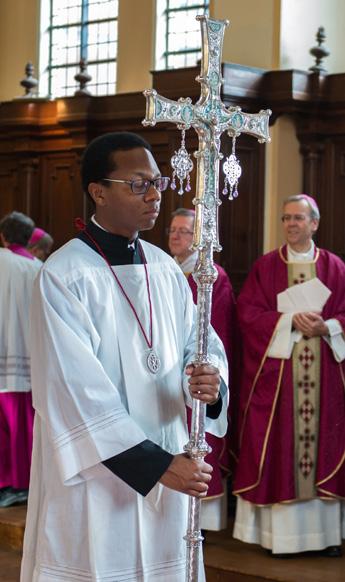
3 minute read
Covid-19 brings a Rediscovery of Mass Rocks
The Head Sacristan Writes
The eagle-eyed amongst you may have noticed that we have not for some months been using the ‘Metropolitan’ Processional Cross, as we usually would for Masses celebrated by our Metropolitan Archbishop and Cardinal. The reason for this is that the stave of the cross is in a perilous state, and urgently requires restoration before it can be used again. The matching candlesticks also require attention.
The processional cross was presented by the Catholic Women’s League in 1912 to Cardinal Bourne. It is by the notable London silversmiths Blunt & Wray. It must be their finest work: sterling silver throughout, the stave chased with scrolls and trellises, set with moonstones and amethysts, some of which are sadly missing. The cross is also chased, and set with enamels, including the arms of Cardinal Bourne. It is engraved with a dedication, and of course has its famous dangling Alpha and Omega.
It is a splendid piece, and a very significant part of the Cathedral’s patrimony, so it is essential that we have it restored to use again as soon as possible. The silversmiths J. McCarthy of Artillery Row have offered us the very reasonable price of £2,500 to fully restore the cross, including repairing a broken piece, replacing the missing stones, and re-enforcing the stave, as well as restoring the two candlesticks. Since this fine firm is located in the parish, it would be particularly appropriate if they were to undertake the work.
If anyone is able to make any contribution towards the cost of this project, please contact Richard Hawker, the Head Sacristan at headsacristan@ rcdow.org.uk, or via Clergy House.
English Priest Holes and Irish Mass Rocks
When, in this country, we think of Mass being celebrated in secret during the centuries of Catholicism being illegal, it is likely that country houses and priest holes will come to mind. In Ireland it is different, as that country knew a tradition of Mass being celebrated outdoors where people could come together in remote locations, with suitable rocky outcrops being used as altars – ‘Mass rocks’. The locations of some of these are well-known these days, but the advent of the pandemic has given them a new significance.
In many instances, a stone would be taken from a church ruin, and relocated to a rural area, with a simple cross carved on its top. Because the activity was illegal, services were not scheduled and parishioners were obliged to spread the word informally. Some of the Mass rock places may also have been used for patterns, the celebrations of the feast day of a local saint. From 1695 to about 1750, life was difficult for Irish Catholics; churches were closed, bishops banished and priests forced to leave the country. Even with this risk, priests continued to celebrate Mass for the people in these outdoor locations, passed down orally, because including them on 17th- and 18th-century maps would have legitimized the Catholic faith.
The Mass rocks are an important part of Irish heritage, according to Dr Bishop of the University of Liverpool, who notes: ‘They are the symbol of the penal laws, of Catholic heritage. They are what kept the faith alive throughout the penal era. If Gaelic communities hadn’t gone to the Mass rocks, the faith would have died out’. Currently there are about 400 Mass rocks recorded, many of which are inscribed with a cross. Dr Bishop believes there are probably ‘many, many more’. ‘I suppose there comes a point where certain generations are less interested in the sites and less interested
© Florentchevallier in their religion and their heritage, partly because a lot of them are not physically recorded anywhere, so if somebody knows of one and doesn’t pass The Mass Rock of Badgerhill that information on, then the knowledge of that Mass rock is lost. When some say that they find Mass no longer relevant, I think of the Mass rocks, and the love of the Mass that inspired priests and people to gather there in all weathers, and in spite of great danger.’
In recognition of this, ACN Ireland has, in the last year, arranged for Mass to be offered on a Mass rock in each of Ireland’s 26 dioceses, with the intention of the revival of the faith across the country.










